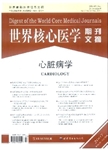发生在心脏起搏时的心力衰竭
Heart failure during cardiac pacing作者机构:Cardiac Arrhythmia Service Brigham and Women's Hospital 75 Francis St BostonMA 02115 United States Dr.
出 版 物:《世界核心医学期刊文摘(心脏病学分册)》 (Digest of the World Core Medical Journals(Cardiology))
年 卷 期:2006年第2卷第7期
页 面:40-40页
学科分类:1002[医学-临床医学] 100201[医学-内科学(含:心血管病、血液病、呼吸系病、消化系病、内分泌与代谢病、肾病、风湿病、传染病)] 10[医学]
主 题:心脏起搏 右室心尖部 传导阻滞 心功能 非同步 射血分数 心脏协会 波群 窦房结功能不全 房颤治疗
摘 要:Background -Right ventricular apical(RVA) pacing creates abnormal left ventricular contraction, hypertrophy, and reduced pump function. The adverse effects of ventricular desynchronization may explain the association of RVA pacing with an increased risk of heart failure hospitalization(HFH) in clinical trials. Methods and Results -Baseline and postimplantation variables were used to predict HFH in the Mode Selection Trial, a 2010-patient, 6-year trial of dual-chamber(DDDR) versus ventricular(VVIR) pacing in sinus node dysfunction. A Cox model showed that New York Heart Association(NYHA) class at baseline and follow-up predicted HFH(hazard ratio[HR], 3.99; 95%confidence interval[CI], 2.74-5.79 for NYHA class III/IV and HR, 2.17; 95%CI, 1.54-3.04 for NYHA class II versus class I); other predictors were heart failure(HR, 2.30; 95%CI, 1.70-3.11),atrioventricular(AV) block(HR, 1.48;95%CI, 1.11-1.97), and myocardial infarction(MI)(HR, 1.37; 95%CI, 1.00-1.86). Postimplantation predictors were VVIR cumulative percent ventricular pacing(Cum%VP) 80(HR, 3.58; 95%CI, 1.72-7.45),DDDR Cum%VP 40 or VVIR Cum%VP ≤80(HR, 1.81; 95%CI, 0.94-3.50) versus DDDR Cum%VP ≤40; whether QRS duration(QRSd) was paced or spontaneous(HR, 2.21; 95%CI, 1.39-3.54; spontaneous versus paced); and drugs for atrial fibrillation(HR, 1.60; 95%CI, 1.19-2.15). Low baseline ejection fraction(EF) and postimplantation RVA-paced or spontaneous QRSd predicted HFH; the increased risk with QRSd was steeper for normal versus low EF(HR, 1.18; 95%CI, 1.11-1.27; versus HR, 1.08; 95%CI, 1.01-1.15; for a 10-ms increase); at a QRSd of ≈200 ms, normal-and low-EF patients had equivalent risk. HFH risk nearly doubled when VVIR Cum%VP was ≤80 or DDDR Cum%VP was 40 versus DDDR Cum%VP ≤40 and was additive with other risk factors. Conclusions -Differences in HFH risk can be explained by interactions between substrate(atrial fibrillation, AV conduction, heart failure, MI, EF) and pacing promoters(ventricular desynchronization-p



